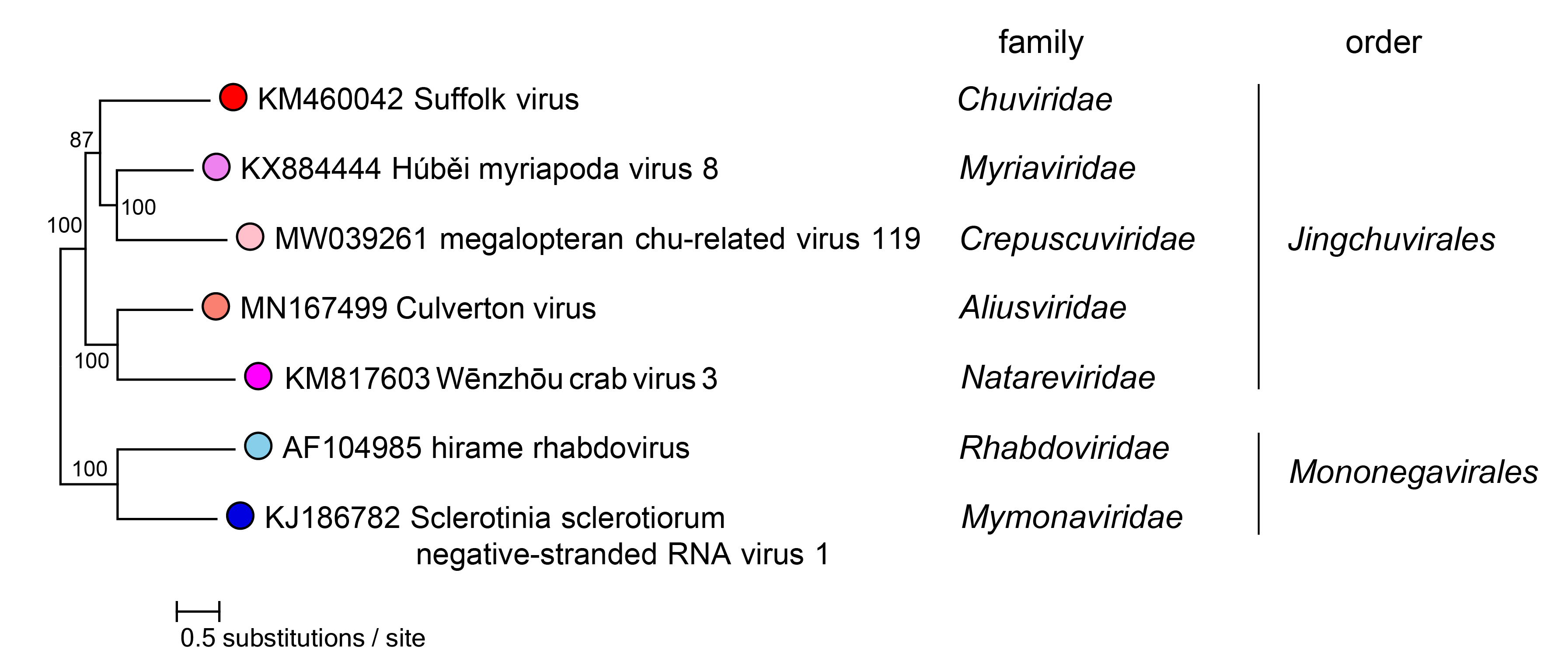Family: Myriaviridae
Jens H. Kuhn, Nolwenn M. Dheilly, Sandra Junglen, Sofia Paraskevopoulou (Σοφία Παρασκευοπούλου), Mang Shi (施莽), and Nicholas Di Paola
The citation for this ICTV Report chapter is the summary published as:
Corresponding author: Nicholas Di Paola ([email protected])
Edited by: Jens H. Kuhn and Stuart G. Siddell
Posted: November 2023
Summary
Myriaviridae is a family of negative-sense RNA viruses with genomes of about 13.5 kb (Table 1.Myriaviridae). These viruses have been found in arthropods in China and in sequence read archives from mollusks. The family includes a single genus with one species for one virus. The myriavirid genome contains four open reading frames (ORFs) that encode a glycoprotein (GP), two proteins of unknown function, and a large (L) protein containing an RNA-directed RNA polymerase (RdRP) domain.
Table 1.Myriaviridae. Characteristics of members of the family Myriaviridae
| Characteristic | Description |
| Example | Húběi myriapoda virus 8 (KX884444), species Myriavirus myriapedis, genus Myriavirus |
| Virion | Unknown |
| Genome | About 13.5 kb of nonsegmented negative-sense RNA |
| Replication | Unknown |
| Translation | Unknown |
| Host range | Myriapod arthropods |
| Taxonomy | Realm Riboviria, kingdom Orthornavirae, phylum Negarnaviricota, class Monjiviricetes, order Jingchuvirales; the family includes one genus and one species. |
Virion
Morphology
Unknown.
Nucleic acid
Myriavirids have nonsegmented linear negative-sense RNA genomes with total lengths of about 13.5 kb (Shi et al., 2016).
Genome organization and replication
Myriavirid genomes have four ORFs that encode a GP, two proteins of unknown function, and an L protein (Shi et al., 2016) (Figure 1.Myriaviridae). The replication cycle of myriavirids remains to be elucidated.
 |
| Figure 1.Myriaviridae. Genome organization of Húběi myriapoda virus 8. ORFs are colored according to the predicted protein function. GP, glycoprotein gene; L, large protein gene. Grey color indicates ORFs encoding proteins of unknown function. |
Biology
The only classified myriavirid, Húběi myriapoda virus 8 (HbMV8), has been associated with myriapod arthropods sampled in China (Shi et al., 2016). Unclassified myriavirids have been associated with cephalopods.
Derivation of names
myriapedis: from myriapod and from the Latin pedis, meaning “of the foot”
Myriaviridae, Myriavirus: from the Greek μύριοι (mýrioi), meaning “myriad”
Genus demarcation criteria
Not applicable (the family includes only a single genus).
Species demarcation criteria
Not applicable (the only genus includes one species).
Relationships within the family
Phylogenetic relationships of members of the family Myriaviridae are shown in Figure 2.Myriaviridae.
 |
| Figure 2.Myriaviridae. Phylogenetic relationships of Myriaviridae. Maximum-likelihood tree (midpoint-rooted) inferred by using RNA-directed RNA polymerase gene (L) sequences. Sequences were initially aligned by MAFFT version 7 (https://mafft.cbrc.jp/alignment/software/) in Geneious version R9 (http://www.geneious.com) and realigned using ClustalW (https://www.genome.jp/tools-bin/clustalw). The tree was estimated using PhyML 3.0 (http://www.atgc-montpellier.fr/phyml/), a subtree pruning and regrafting (SPR) topology searching algorithm, and a Bayes branch support algorithm. Numbers near nodes on the trees indicate bootstrap values as percentages. Tree branches are scaled to nucleotide substitutions per site (scale bars). Two members from the Mononegavirales order were included as an outgroup. |
Relationships with other taxa
Myriavirids are most closely related to jingchuviral aliusvirids, chuvirids, crepuscuvirids, and natarevirids (Shi et al., 2016, Di Paola et al., 2022).
Related, unclassified viruses
| Virus name | Accession number | Virus abbreviation | Reference |
| Cephalopod myriavirus-like virus 1 | Rey-Campos et al., 2023 |
Virus names and virus abbreviations are not official ICTV designations.

